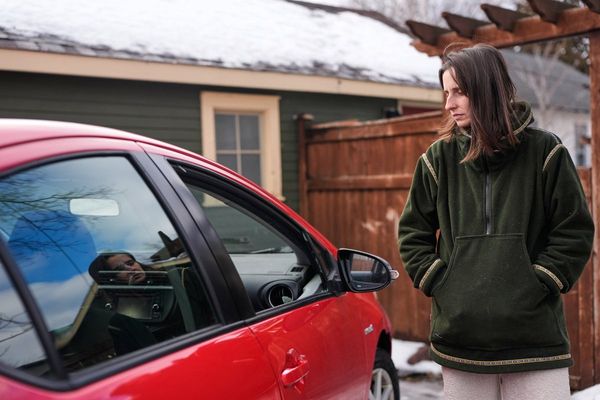
When Tony Wolfe started out as an apprentice, aged 15, at the Hazelwood coal-fired power station he had a job for life.
Now he has a six-year-old granddaughter and says he wants her to have an opportunity to enter the energy industry, with long-term career prospects, rather than have to leave her region in 10 years to find work.
"I'm a coal worker advocating for renewables, so I'm a bit of a square peg in a round hole," he said during a visit to Parliament House in Canberra with the team behind one of Australia's most advanced offshore wind projects.
"I've been advocating for renewables for about 15 years, because the writing's been on the wall that coal is going to end."
But he's concerned that a decade from now, the offshore wind industry - long established elsewhere - will still be in its infancy in Australia.
"The thing that exercises my mind is the urgency with which we need to do this within Gippsland ... I don't think people understand," Mr Wolfe said.
"We've got to build a complete new workforce for this industry, and we've got the opportunity to make that workforce truly reflective of the community that it serves, and I mean gender-balanced, diverse and flexible."

Closure dates are in place for all of Victoria's coal-fired power stations, including one of Australia's biggest - Yallourn in Latrobe Valley - in 2028.
That's just around the corner, and if the state meets its offshore wind target to make two gigawatts by 2032, it will just cover the closure of Yallourn, Mr Wolfe warned.
"The question I get asked is: why haven't they started building yet," he said.
Once Australia's most carbon-intensive electricity generator, Hazelwood and its coal mine were shut in 2017 and the area became a political battleground in the country's ongoing climate wars.
Some say why not use the 800 years of coal we're leaving in the ground, but Mr Wolfe said the best thing to happen to the region was getting the end date set in place.
Fifth-generation Novocastrian, Sharon Claydon, who is deputy speaker and federal MP for Newcastle, is equally excited about what new energy sources will bring to her region.
Once known as a steel city, BHP was Newcastle's biggest employer until the steelworks closed in 1999, leaving a deepwater port and plenty of industrial land adjacent to a future Hunter offshore wind zone located off the coast of NSW.
"Twenty-odd years ago now, BHP, in a boardroom somewhere across the other side of the globe, made a decision that they were going to shut up shop in Newcastle and leave us," Ms Claydon said.
"There was a bit of a divorce settlement that went on for a while, and a lot of people who don't know Newcastle wrote us off."
Ms Claydon says the region has a highly skilled workforce that already knows what to do with energy, a great university and TAFE, and is perfect geographically for offshore wind.
Health and education have become the biggest employers, alongside plans for a thoughtful transition in the way the area generates, stores and distributes energy, including to new advanced manufacturing workshops.
Chief executive of Southerly Ten, Charles Rattray, leads the team behind Australia's most advanced offshore wind projects, Star of the South, located 10km off the south coast of Gippsland, which could supply one-fifth of Victoria's electricity.

Backed by Copenhagen Infrastructure Partners, Southerly Ten also a proposal for Destiny Wind off the Hunter coast and the Kut-Wut Brataualung project off Wilsons Promontory in Victoria.
"If we were to build these three projects, we're talking about thousands of jobs and over $20 billion of investment into the Australian economy," Mr Rattray said.
"It's a really significant, generation-changing investment in Australia's energy transition," he said.
Mr Rattray said offshore wind had a very special role in the electricity grid because of the way it dovetails with onshore wind.
When onshore wind is at a low ebb or when solar farms power down with the sun, offshore Gippsland wind is typically an incredible wind resource at times of peak demand, he explained.
There's a similar characteristic ahead for Newcastle, along with what is known as solar-wind complementarity, in a national grid where different renewable electricity sources and energy storage will co-exist.
He said investors have been particularly keen to get started in Gippsland, with the state's offshore wind targets providing certainty.
Daniel Miller, CEO of the Gunaikurnai Land and Waters Aboriginal Corporation, said they have had 100 years of extractive industry.
"There's three big holes in the ground in Latrobe Valley and also 23 oil and gas rigs offshore," he said.
"We've had energy security because of that but the legacy it's left is really significant ... this opportunity can take us into the future and not have that impact to country."
Mr Miller said offshore wind represents a "once-in-a-generation or greater" opportunity for the Gunaikurnai people who have native title over a large part of Gippsland, which is directly adjacent to the first offshore wind zone set for Australia.
"Southerly Ten have a higher social conscience and value traditional owners the way that they should," he added.
Others are also lining up to secure licences to develop in six priority offshore wind areas, dotted around the coastline, but the NSW government has been told to get up to speed.
"The Hunter is well and truly under transition ... we've had coal-fired power stations close, we've had coal mines close, we're an industry region," Justin Page, co-ordinator of the Hunter Jobs Alliance, said.
He said there was also a solid manufacturing base and no reason why the region couldn't start making the wind towers.
"Aim big ... there's no reason why we can't shoot for the stars," Mr Page said.
The real measure of success would be the use of local companies to create long-term meaningful jobs and prosperity for our regions, he said.
It typically takes around seven to 10 years to develop an offshore wind project, and a handful of feasibility licences were recently issued.
Historically, there's been bipartisan support with the coalition passing legislation for offshore electricity infrastructure and the Labor government putting the meat on the bones with licensing and regulations.
But the states are going at different wind speeds, with Victoria well ahead of NSW, Mr Page warned.







